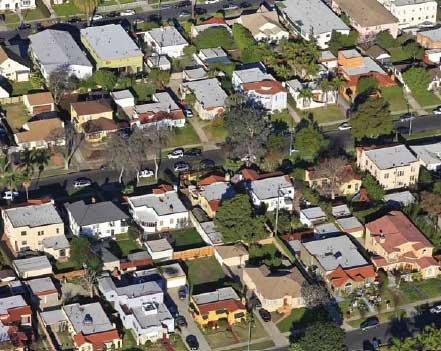Why Now Is a Smart Time to Consider Updating Your General Plan
Eva Spiegel is communications director for the League and can be reached at espiegel@cacities.org. Jude Hudson is editor in chief of Western City and principal of the Sacramento-based strategic communication consulting firm Hudson + Associates; she can be reached at jude@surewest.net. Dan Carrigg, the League’s legislative director, also contributed to this article.
California law requires every city and county to periodically update its General Plan, the document considered by many to be the Constitution for land-use decisions at the local level. But in today’s economic climate, most local officials are focused on budget cuts and balancing their agency’s budget. At first glance, updating the General Plan may not seem like a high priority. It’s a costly exercise, and finding the necessary funds can be difficult. However, now is an excellent time to begin updating your General Plan.
Why a General Plan Update Is Worth Doing Now
The economic downturn has provided a new opportunity for local governments to focus on their general plans. During periods of economic growth, high volumes of impending or proposed development often create immense pressure on local officials to move ahead quickly. Making decisions under such duress doesn’t allow much time for considering the potential impacts that may result later. The current economic downturn gives local officials and their communities the breathing room to think long term about the future, without the constant distractions and pressures of project-driven priorities associated with boom periods. When things are slow and little development is occurring, there are fewer hot issues to fight about — which are exactly the sort of issues that tend to muddy the water and confuse conversations about long-term planning. During this type of lull, it’s possible to take the time to develop a General Plan that’s carefully crafted with thoughtful community input and expert assistance.
In today’s economy, the consulting services that support General Plan updates are priced much more attractively as planning consultants and others who assist with these projects compete for work. The chances of getting high-quality assistance for a good price are greatly improved right now — a plus for cities and counties seeking the best value for their scarce dollars.
Another thing to think about is that the update process offers the chance to re-examine the economic assumptions underlying the General Plan. Many economists expect that the post-recovery economy of the near future will be unlike the booming pre-recession economy. They predict a “new normal.”
Cities and counties are well advised to consider these factors when planning ahead. Economic assumptions made just three or four years ago may likely be invalid. For example, one popular way to fund infrastructure has been through Mello-Roos districts, which involve working with a developer and issuing bonds. This approach worked well during past booms in communities where rapid growth appeared to be a given and it seemed safe to assume that ever-expanding, lower-density housing would continue to be developed at a brisk pace. However, not only did the pace of development slow dramatically, but those very types of lower-density developments were subsequently hit hard by waves of foreclosures. Thus, a General Plan that assumes rapid ongoing low-density development in such a community may be outdated, and its assumptions may need to be re-evaluated. In a related vein, communities that are built out and focused on infill may find it timely to re-examine their General Plan’s assumptions related to density.
A General Plan is more likely to withstand pressure to change it when it has been updated in a comprehensive way with public input and all the necessary environmental documents have been completed. Such a plan can work well for residents and community activists because they know what they want and have agreed to in terms of their collective vision for the future. When the public is engaged in the planning process and the updated General Plan reflects that, a win-win situation ensues. Not only does the community have a clear picture of its priorities, but developers also benefit from the certainty that community members are essentially on the same page. A solid, updated General Plan also helps entrepreneurs and business people better understand what the community wants. And when the baseline environmental work has been completed as part of the update process, projects consistent with local plans are likely to enjoy broader community support.
Going About It the Right Way: Public Engagement
State law requires local governments to involve the public in developing and updating the General Plan, and it’s one of the most significant ways that residents engage in local government decision-making. Using many different techniques and tools throughout the update process helps cities and counties to ensure the participation of the largest possible cross section of the community. The goal is to engage more than just “the usual” people who attend public meetings. Local governments use public noticing, print and broadcast media, the Internet and more to promote and attract public participation. Residents can offer public comments on proposed policies at town hall meetings and other forums, as well as at city council meetings and hearings conducted by the local planning commission.
A broad range of resources on land-use planning (www.ca-ilg.org/landuse) and civic engagement (www.ca-ilg.org/engagement) is provided for local officials by the Institute for Local Government (ILG), the nonprofit research arm of the League and the California State Association of Counties. ILG promotes good government at the local level with practical, impartial and easy-to-use resources for California communities.
“More public engagement occurs in the planning area than in any other activity that cities or counties are involved with,” reports Terry Amsler, ILG’s Public Engagement and Collaborative Governance program director. “Rather than simply using traditional engagement approaches where the public is brought in later in the process to review plans that have already been drafted, now communities involve people early in the process to think through planning issues, consider their priorities and envision what kind of community they want to have.”
In Richmond, the city sent staff out in a van into neighborhoods to reach out with information about the General Plan update process and also used a website to solicit comments from residents. “Community residents typically are not expert planners, but they have information to provide and play an important role,” Amsler observes.
“In updating the General Plan, members of the community partner with experts,” says Steve Sanders, director of ILG’s Land Use and Healthy Neighborhoods programs. “Residents bring to the table their preferences, values and hopes for the community’s future quality of life. Planners and professionals bring a way of translating that into actual plans and processes.”
“It’s a major decision, and it’s appropriate to involve the public in it,” says Tom Pace, long-range planning manager with the City of Sacramento’s Community Development Department. About 4,500 Sacramento residents participated in Sacramento’s recent General Plan update. “While we initially set out to have robust public involvement, the city council really expanded the effort to reach out into every nook and cranny to engage people who aren’t normally involved in local government or planning issues,” Pace explains. The city advertised on Hmong radio stations, made presentations at African-American churches and held 25 town hall meetings, including some that specifically targeted high-school and college students. In addition, when the draft plan was released the city held four open houses throughout the community to solicit feedback.
In Southern California, the City of Ontario is creating an entire new downtown in its airport area where 250 acres of land stand vacant. It will take 20–30 years to fully plan and develop, but it represents Ontario’s vision of its future with high-density mixed-use zoning and access to transit, including a stop on the light-rail system linking the city with Los Angeles.
Ontario used multiple techniques to engage the community in developing this vision, first conducting interviews with council members, city commissioners and department heads to identify issues that will affect the city over the next three decades. City officials met with local business leaders to focus on economic development aspects and held a five-hour workshop for residents that focused on the future of the new downtown. In the area surrounding the airport, city staff talked to hundreds of residents in meetings about the proposed major land-use changes.
“It’s not just about the built environment but also about what happens in it — the services, social activities and more,” says Ontario Planning Director Jerry Blum. Ontario is committed to revisiting its plan annually. “By ensuring that the council is involved in looking at policy directions each year, it then becomes the community’s plan, not just the Planning Department’s plan,” Blum adds. “It’s important that this plan is sustainable for many future councils and their staff.”
Be Prepared for the Costs
A well-executed General Plan creates a blueprint for the community’s future growth and, ultimately, its quality of life. So it’s not surprising that updating the General Plan is an expensive project for local governments. Some county general plans cost upward of $10 million, and large cities’ general plans sometimes run into the millions. The City of Sacramento spent about $4 million on its plan update, and Ontario spent $3 million, plus staff time for both cities. The City of Santa Monica spent $2.3 million plus staff time. The more expensive general plans typically take the city in a new direction and include extensive analyses beyond the required environmental impact report (EIR). The cities of Ontario and Sacramento both executed these types of plans.
A city of 100,000 might expect to spend $800,000–$900,000 on a General Plan. The EIR is actually one of the most expensive components of the entire process and can cost $200,000 on the low end. Even a city of just 5,000 may spend at least $400,000–$500,000 on its General Plan.
The Advantages of Starting Now
Despite the financial challenges, there are some solid reasons to begin a General Plan update now rather than later. As noted earlier, services are priced more competitively in today’s economy. But just as important, the slower housing market means that local governments are able to operate without the pressure traditionally exerted by a list of pending projects. Making sound, informed decisions is easier in an environment where community discussions can be conducted without the looming prospect of imminent development. It’s a good idea to have the necessary conversations about planning for the future when elected officials and community members alike are not overwhelmed by political pressure and numerous competing development proposals.
While these are hard times, local officials who nevertheless take a proactive stance on updating the General Plan will find their communities better prepared when the economy eventually turns around. Savvy local leaders will look for less expensive ways to begin the process and take advantage of the free and low-cost resources provided by the Institute for Local Government and others (for additional information, see “More Resources Online” at right). Lay the groundwork now to develop a solid long-term plan that unites your community in realizing its vision for the future.
Some Background on General Plans
A General Plan must include seven specific elements — land use, circulation, housing, conservation, open space, noise and safety. It may also contain other permissive elements related to land-use development, including (but not limited to): urban design; economic and fiscal development; capital improvements and public facilities; air quality; energy; flood management; geothermal resources; and water. Yet the General Plan process offers a great deal of latitude to create a vision for the community that reflects its residents’ unique needs and those of the surrounding region.
State law requires that local governments update their general plans periodically but doesn’t specifically define how often. The housing element, however, which is one of the seven mandatory elements, must be updated every five to eight years, depending on which update requirement applies to the region in question. All general plans must also include an Environmental Impact Report (EIR) to satisfy the California Environmental Quality Act.
Local governments traditionally drafted their general plans focused solely inside the city limits or county lines, but that has changed. Today, taking neighboring cities and the region as a whole into consideration is an essential part of the process. General plans are increasingly being drafted in the context of regional sustainable communities strategies that address greenhouse gas reduction through land-use, housing and transportation planning (for more information, see “City Officials Think Regionally to Tackle Transportation, Housing and Environmental Issues.”
A General Plan update typically takes 12–18 months, but can last as long as five or six years depending on the circumstances. The City of Ontario adopted its General Plan, called the Ontario Plan, in 2010 following a four-year process. The previous update was completed in 1992. The City of Sacramento began its General Plan update in 2004 and adopted the plan in March 2009. In both instances, the cities extensively engaged residents in the update and used the General Plan to create a long-term vision going beyond issues of land use.
Experts advise local government officials to examine their General Plan at least every 10 years. Economic and other conditions change, and projects approved by the city or county must be consistent with the General Plan. Regularly updating the plan enables a local government to consider and plan for the community’s needs based on thoughtful analysis, public input and current conditions.
Helpful Resources From the
Institute for Local Government
- SB 375 and Regional Planning
- Planning Sustainable Communities
- Understanding the Basics of Land Use and Planning
- Participating Effectively in the Planning Process
- Understanding the Basics of Land Use and Planning: A Guide to Planning Healthy Neighborhoods
- Understanding the Basics of Land Use and Planning: A Glossary of Land Use and Planning Terms
- Demystifying Land Use Terminology for the Public: Public Hearing One-Pagers
- Public Engagement and Collaborative Governance (Intro)
- Public Engagement: Planning, Housing, & Redevelopment
- Principles of Local Government Public Engagement
California Planning Roundtable Launches
“Reinventing the General Plan”
Long-range planning is the key mechanism for communities to identify and pursue great visions for their future. Recently, however, many communities have struggled with significant political, fiscal and legal barriers to effective long-range planning. These challenges are compounded by the requirements of SB 375 and the impact of an ongoing economic downturn.
That is why the California Planning Roundtable, an organization of planners from the public, private and academic sectors, has launched a project called Reinventing the General Plan. It includes an online “incubator” at www.ReinventingTheGeneralPlan.org that provides models and examples of outstanding general plans. The incubator’s purpose is to catalyze innovative thinking for staff, city leaders and the public about the potential of the General Plan.
The project’s blog, at www.ReinventingTheGeneralPlan.org/Blog/, offers a way to share stories of General Plan experiences and ideas for its reinvention. The California Planning Roundtable also welcomes submissions of other models for inclusion on the site.
This article appears in the March 2011 issue of Western City
Did you like what you read here? Subscribe to Western City



